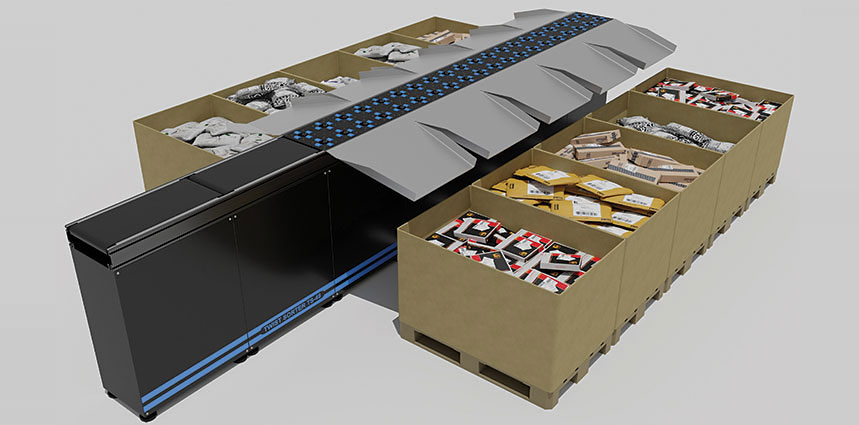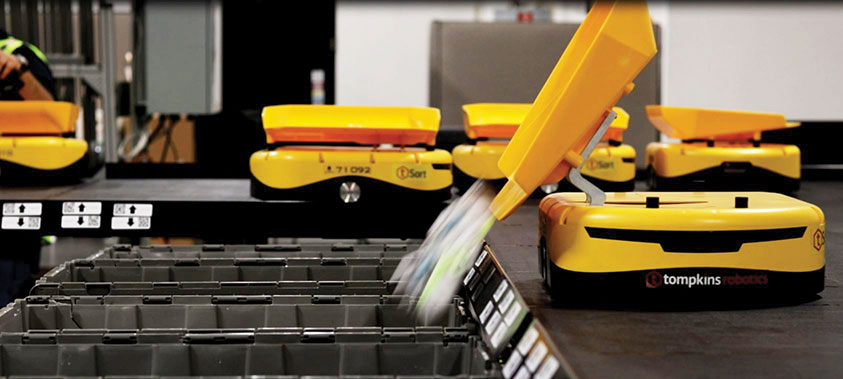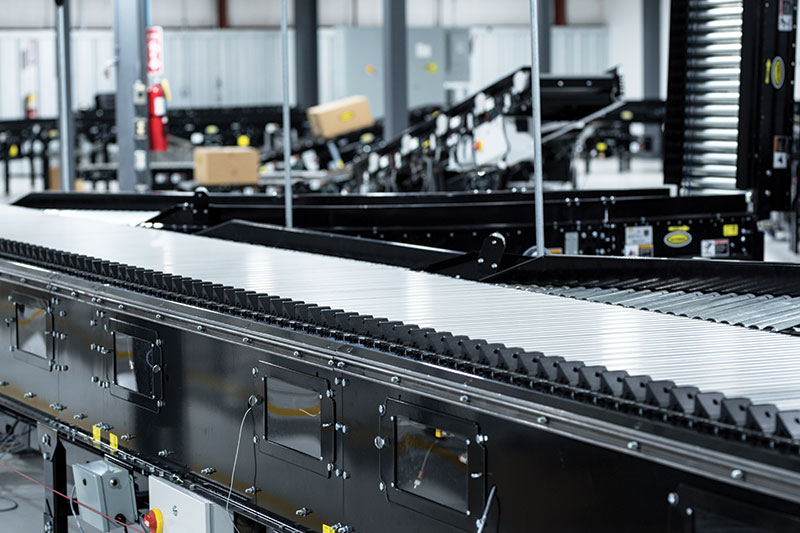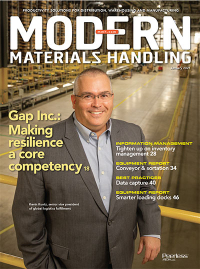E-commerce’s Imprint on Conveyor & Sortation
From smaller, more irregular packages, to new market segments like micro-fulfillment automation, the change driven by e-commerce is reflected in the conveyor and sortation market. Add in the need to offer systems that are faster to put in and more adaptable over time, and you see multiple reasons for these trends.
Conveyor and sortation systems remain at the heart of automated material flow in many warehouses. While mobile robots and automatic guided vehicles (AGVs) are alternative means of automated transport, and semi-automated systems like putwalls can do sortation, it’s not as if the need for conveyor/sortation is on the wane.
On the contrary, with the growth of e-commerce and faster delivery cycles expected for store replenishment, DCs continue to deploy conveyor and sortation systems at a healthy pace. According to a recent analyst report from Technavio, the global conveyor and sortation market is expected to grow at compound annual growth rate of more than 5% through 2024.
Conveyor and sortation solutions are changing, however, to adapt to new types of packages, processes and market niches. Some vendors are even using mobile robots with tilt trays or other attachments on top to mimic the functionality of fixed sortation, while some conveyor suppliers also have products that address emerging niches such as micro-fulfillment.
E-commerce growth is a common denominator in these trends. All those small consumer orders are often shipped in polybags, padded envelopes or other small and lightweight packages that present challenges different from corrugated boxes. Here are a few top trends and insights from conveyor and sortation vendors.
Taming pesky polybags
With e-commerce driving greater use of polybags, conveyor and sortation systems may have to be changed or adapted to handle these items. According to Tim Kraus, a product manager with Intralox, the issue with polybags is that unlike traditional corrugated cartons, they don’t have uniform, flat bottoms, and second, the same bag size can hold items that are significantly different in weight and shape.
“With boxes and with totes that might hold several orders, conveying is pretty easy because boxes and totes have flat bottoms that are easy to handle and the edges are easy to detect,” says Kraus. “That makes it easier to control the motion. By contrast, with a polybag, it’s much more difficult to control and precisely predict the path of the items, because you are not just handling a bag, you are handling whatever is inside plus new catch points created by the bag itself.”
The same sized polybag, Kraus points out, could be used to ship a relatively small but heavy hammer, or a lightweight replacement O-ring or a sweater. “In singulated polybag flow, it becomes important that you have good transitions from conveyor to conveyor, rather than large gaps from one conveyor to the next,” he says. “This can help avoid problems with polybags getting jammed or losing their tracking location in the software. In bulk polybag flow, it’s important to make sure you’ve eliminated any catch point, and to use waterfall transitions instead of completely level transitions.”
If a DC is doing more e-commerce shipping of polybags, it’s wise to revisit rougher transitions and maybe put in different transitions to be able to deal with smaller items, adds Kraus.
With singulation also being difficult with polybags, adds Kraus, some facilities are moving from singulated flow they used for larger cartons to a bulk flow for polybags or mixed package types, with sortation done later. Going to bulk flow allows for use of a fairly simple conveyor to move from an order packing area of the building to shipping.
With new systems and improvements, it may be best to opt for sorters well suited for small items. Intralox offers a type of belt it calls Activated Roller Belt, or ARB. This type of belt, explains Kraus, uses many small rollers that can be activated to change direction of the goods being conveyed, making it a good type of belt for handling polybags or other lightweight items for more complex functions like bulk sorting, singulation and single-item sorting.
“We use the ARB technology in many ways, but it’s ideal for polybags because it has many small points of contact,” Kraus says.
Up with low voltage
Not only has rapid e-commerce growth changed the type of packages that need to be handled, it also drives the need for materials handling systems that are simpler and quicker to install, since many companies are trying to rapidly expand fulfillment reach. These needs are being met by trends that include low-voltage conveyors that have fewer subsystems (no need for air compression and piping), modular, and typically are quicker to deploy than most larger conveyor systems with AC drives, says Mitch Smith, vice president of business development with Hytrol.

“We all knew e-commerce would continue to grow, but with Covid-19, that pace of growth has accelerated quicker than expected,” says Smith. “In this environment, the ability to quickly implement systems and streamline projects has become more important. The reason low-voltage systems meet these needs is that they are generally smaller conveyors, and they’re quicker to install from a mechanical perspective. Electrically, they go in pretty fast, and we’ve also learned over the years that they are pretty easy to reconfigure.”
Low-voltage systems can be used in conjunction with segmented belt accumulation conveyor that excels at conveying smaller, lighter packages common with e-commerce, says Smith. While low-voltage systems tend to cost more than some other types of conveyor systems, it can be justifiable. “To justify low voltage, you have to look at its value more holistically, taking into consideration its cost of ownership and time and speed of installation,” says Smith.
Smaller packages to handle is also influencing sortation systems. To meet this need, Smith says Hytrol offers the ProSort 1100, a smaller, high-speed sliding shoe sorter with a breakaway shoe, offered as a linear sorter that can sort bidirectionally. “With that design, you can get a lot of diverts and high speeds for handling smaller packages, at a relatively low cost point compared to some competing designs,” says Smith.
While more traditional conveyor systems with AC drives can continue to be a wise choice for many operations, the need for rapid deployment and flexibility is growing and reflected in some conveyor options, says Smith. For example, he says, Hytrol now offers simple, low-voltage conveyors that are essentially mobile to serve the needs of “pop up” fulfillment sites that use tents or other temporary locations.
These conveyors have folding leg supports with casters, so they can be brought to a site and rolled into place and connected with a simple control system to do material transport within the pop-up site. “When the need for the pop-up location drops off, that conveyor can be folded up and moved to the next site to use for the next peak or busy season,” says Smith.
Low-cost sortation
With the need to efficiently sort goods to accommodate omni-channel fulfillment, sortation solutions with good throughput, a relatively low price tag, and high adaptability are in demand, says Eric Willems, managing director for Flowsort, a Dutch company that offers a modular sorting system, working with integrators and conveyor system builders.
Willems says there’s a need for lower cost systems that can sort at a rate of 2,000 to 8000 items per hour, which is a slower throughput than some cross-belt or sliding shoe sorter solutions, but carries a significantly lower cost than most high throughput sortation systems. “There is a big market need for systems in this throughput range, but almost no solutions,” he says.
The Flowsort sorter modules use small rotating wheels arranged in rows to perform sorts that makes them capable of handling a variety of larger to small packages, including most polybagged items, says Willems.

The modules can connect with each other quickly over Ethernet. “It is easy to make changes to the system over time because of the modularity,” says Willems. “If you’re a third-party logistics (3PL) facility, and there’s a change in your business that impacts the products you handle and the sortation needs, it’s easy to remove or add modules to make it fit again for the new application.”
Robotic sortation
A relatively new type of sortation approach is to use mobile robots with sortation mechanisms on top, rather than fixed sortation. Mobile sortation robots can be an alternative to fixed sortation or other less fully automated means of so of sortation such as putwalls, says Mike Futch, president of Tompkins Robotics.
Tompkins Robotics’ “t-Sort” features independently moving robots that transport goods across a raised platform from an induction station to designated divert locations, where they stop and perform the sort.
All system elements are modular and portable, says Futch, which enables rapid implementation, expansion or moving of the system to a different site. Unlike fixed conveyor/sortation, there is no hardwired electrical work, sprinkler systems, or permitting needed to put in a system, adds Futch.
“When we created t-Sort, the whole idea was to do sortation in an entirely different way,” says Futch. “The biggest difference is flexibility. Everything you see in one of our systems is on wheels. You roll the components out of a truck, you can hook them together into whatever shape you want, and so it’s highly configurable. And you can quickly add to it at any time, so it’s easily scalable.”
The t-Sort features multiple interchangeable tray and crossbelt designs capable of handling a variety of products including round, cylindrical, lightweight, apparel or footwear. Since launching the solution in 2018, there were 21 implementations as of late 2020, with some customers having more than one site.
The typical t-Sort implementation can be done in four to eight weeks, though one system was installed in late 2019 in two weeks, says Futch. Once the first implementation is completed with integration to a host system such as a warehouse management system, subsequent similar deployments can be more rapid.
The mobile nature of the system also makes it possible to move a t-Sort to accommodate different peak seasons at different facilities in a DC network, or to rapidly enable automated sortation at a new DC.
Telescoping conveyor
One the impacts of doing more e-commerce fulfillment at DCs is that items like parcels and cartons might be loose loaded into trailers or vans rather than palletized. This can mean plenty of short trips by workers to get such goods loaded or unloaded under a manual method, says Bob Formolo, general manager with Caljan.
Telescoping conveyor comes in different variations (some have a platform a worker can stand on), but the idea is “bring the belt to the box” to eliminate most of the walking, carrying and other small movements in handling loose loaded cargo, explains Formolo. With the touch of a button, a telescoping conveyor can be extended by a worker into a trailer so the conveyor’s belt brings goods right near the point of work, and when unloading, positions the conveyor close to the items that need unloading.
“With telescoping conveyor, we’re able to minimize the number of steps and the overall labor effort involved with loading and unloading loose cargo,” says Formolo. “E-commerce is really starting to increase the need for more automation, including telescoping conveyor.”
For sites that can’t justify a telescoping conveyor for each dock door but still want to quickly deploy one unit to multiple positions, Caljan offers a traversing unit. This unit can quickly move a telescoping conveyor so one conveyor and one traversing unit can cover three doors, says Formolo.
Another Covid-19 area benefit with telescoping conveyor, adds Formolo, is that the increased efficiencies involved may allow one worker to handle a task, rather than a team of workers. “If you used to have two people load or unload a trailer, telescoping conveyor can make it possible to do the task with one person,” he says. “That helps reduce risk by reducing the number of people going in and out of a trailer.”
Micro-fulfillment centers
The growth in e-commerce and consumer interest in curbside or in-store pickup has some grocers and retailers experimenting with micro-fulfillment, which involves putting automated storage and order picking solutions into stores or dark stores. The idea is that by having many automated points of distribution close to customer concentrations, a retailer can excel at fulfillment speed and efficiency.
With some micro-fulfillment solutions don’t incorporate conveyor, some do. But it’s not just any conveyor. It needs to be conveyor with strong data communication, higher speed capabilities, modularity, and precise positioning characteristics, says Barry Miller, conveyor solutions sales director for Interroll.
“We do see a market [with micro-fulfillment], and we’ve been working with solution providers and integrators in this space to leverage our conveyor,” says Miller. “These centers tend to operate at higher throughput and want the flexibility of being able to repurpose the conveyor in different configurations as their needs change. Some of the more advanced micro-fulfillment centers utilize robotic interaction that requires precise product handling for robot collaboration.”
Interroll’s powered roller conveyor is modular, adding to ease of deployment, says Miller. Speed, data communication and precise positioning are achieved through the combination of the 24/48v Interroll EC5000 roller drive and Multi-Control card. This combination allows the roller drive to stop and start rapidly to enable precision positioning of totes. The supplier’s systems can provide approximately 100 points of data feedback on factors including cycle, temperature, position, torque or maintenance requirements, which a solution provider can use for predictive maintenance.
Overall, micro-fulfillment center automation solutions need to be fast and reliable to make orders available quickly for consumers and provide them with a superior level of service. Because of these needs, precise positioning of totes and data feedback characteristics will be needed from conveyor used as part of this growing niche, says Miller. “Speed to consumer delivery has become ‘the’ differentiator for many companies today,” he says. “Products do not differentiate; service does.”
Companies mentioned in this article

Article Topics
Conveyors & Sortation News & Resources
Problem Solved: How a Fulfillment Center Got Back on Track Trew showcases high-throughput modular sortation TrewSort line sorter Coesia acquires AMC, LLC Power Transmission: From horseback to rocket ship Henry Puhl to become the new CEO of TGW Logistics Regal Rexnord to sell its Industrial Motors & Generators businesses to WEG Analyst study: parcel sortation market to top $4 billion by 2030 More Conveyors & SortationLatest in Materials Handling
The (Not So) Secret Weapons: How Key Cabinets and Asset Management Lockers Are Changing Supply Chain Operations MODEX C-Suite Interview with Harold Vanasse: The perfect blend of automation and sustainability Consultant and industry leader John M. Hill passes on at age 86 Registration open for Pack Expo International 2024 Walmart chooses Swisslog AS/RS and software for third milk processing facility NetLogistik partners with Vuzix subsidiary Moviynt to offer mobility solutions for warehouses Materials Handling Robotics: The new world of heterogeneous robotic integration More Materials HandlingAbout the Author
Subscribe to Materials Handling Magazine

Find out what the world's most innovative companies are doing to improve productivity in their plants and distribution centers.
Start your FREE subscription today.
April 2024 Modern Materials Handling

Latest Resources












